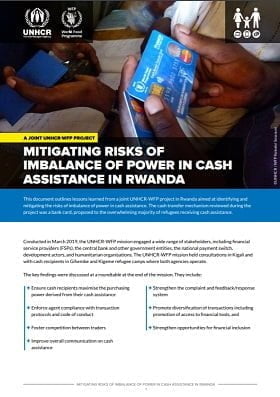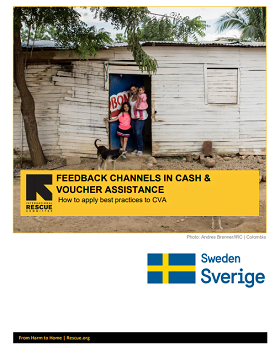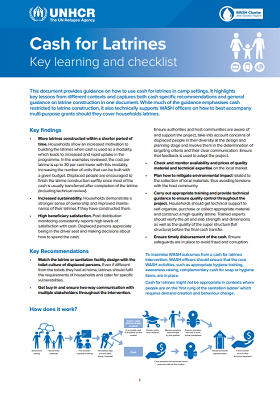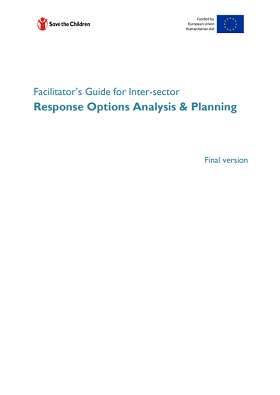Risk
The CALP Network’s State of the World’s Cash report found that the perception that CVA is riskier than other forms of aid was one of the main barriers to CVA being routinely used. This concern is linked to the growing emphasis from donors on anti-terrorism and money laundering, and shrinking budgets for humanitarian assistance. The CALP Network’s work under this theme aims to debunk myths, facilitate collaboration, and share learning to ensure that CVA is systematically and equally considered, based on evidence of actual risks across modalities.
Current priorities
A variety of organisations are currently working on CVA and risk. The CALP Network is working to identify synergies among actors, avoid duplication, and define joint priorities that can be better addressed collectively. Together with WFP, the CALP Network is co-leading the risk priority within the Grand Bargain workstream on cash.
Featured content

Podcast: Will risk aversion hold us back from realizing the potential of CVA?
Podcast
Episode 1 of the CashCast, exploring how attitudes to risk have impacted the use of CVA in the Middle East and North Africa region.

CVA and Risks: What happens in the field, stays in the field?
Blog Post
In October 2019 in Douala, Cameroon, the CALP Network facilitated a learning event exploring the risks to beneficiary protection in Cash and Voucher Assistance (CVA). This closed-door workshop, held as part of series of meetings and webinars on theme of CVA and risk in different regions, convened 25 humanitarian workers from West and Central Africa representing local and international NGOs, UN...

Webinar: Data sharing in CVA: ethics, ownership and privacy
Event
Thematic lead
Latest

Mitigating Risks of Abuse of Power in Cash Assistance in Afghanistan
Report
This document outlines lessons learned from a joint UNHCR-WFP project in Afghanistan aimed at identifying and mitigating the risks of abuse of power in cash assistance. The cash transfer mechanisms discussed during the mission were cash distribution through Hawalas, mobile token, mobile e-vouchers and...

Data Responsibility: Let’s not wait for another wake up call
Blog Post
This blog is the second in a series on cash and voucher assistance (CVA) and risk. While the first blog busted some myths around misappropriation and fraud in CVA, this second blog looks into a specific risk for recipients of CVA: the risk of misuse of personal data.

Cash and Crises Series Episode 2: The Role of Central Banks in Disaster Management
Video
Watch the video here Cash and Crises is a series of financial literacy audiographics brought to you by CashEssentials, a private sector initiative with a social mission to support the relief and development community in understanding how cash is managed for society in times of crisis. In Episode 2,...

Cash is no Riskier than Other Forms of Aid. So Why Do We Still Treat In-kind like the Safer Option?
Blog Post
The first in a new series of blogs on cash and voucher assistance and risk, this article from the CALP Network’s Stefan Bumbacher debunks some common myths around the risk of misappropriation and fraud in CVA.

The UN Common Cash Platform: What does it mean and how is the IRC responding?
Blog Post
Together our members and partners have strengthened the evidence base and advanced the debate around gender and cash and voucher assistance. Looking ahead, how can we ensure we turn talk into action to deliver quality CVA for everyone?

Mitigating Risks of Abuse of Power in Cash Assistance in Rwanda
Report
This document outlines lessons learned from a joint UNHCR-WFP project in Rwanda aimed at identifying and mitigating the risks of imbalance of power in cash assistance. The cash transfer mechanism reviewed during the project was a bank card, proposed to the overwhelming majority of refugees receiving cash...

Cash and Crises Series Episode I: Digital Money
Video
Cash and Crises is a series of financial literacy audiographics brought to you by CashEssentials, a private sector initiative with a social mission to support the relief and development community in understanding how cash is managed for society in times of crisis. In Episode 1, we start with a short...

Safer Cash Toolkit (English)
Guidelines and Tools
The Safer Cash Toolkit, funded by USAID, is designed to capture the minimum amount of protection-related information in emergency settings to ensure that organizations can make informed decisions on how to design, implement and adjust CVA programs at the field level to prevent and minimize harm. The Safer...

Child Safeguarding for Cash and Voucher Assistance Guidance
Guidelines and Tools
As cash and voucher assistance (CVA) becomes ever more prevalent, it is more important than ever for humanitarian and development actors to act to prevent and mitigate associated child safeguarding risks.
Children are particularly vulnerable, and even more so in emergencies. The impact of CVA on...

Feasibility Study on Cash Transfer Programming for the Returnees and the Host Communities in Gedeo and West Guji in Ethiopia
Report
This document reveals the outcome of a feasibility study on cash transfer programming targeted for the returnees and the host communities in Gedeo and West Guji Zones.
The major objectives of the study were as follows:
1. Understand general cash transfer environment in Ethiopia
2. Validate the needs of...

Cash & Voucher Assistance and Gender-Based Violence Compendium
Guidelines and Tools
The Compendium is intended as a companion to the 2015 Inter-Agency Standing Committee (IASC) Guidelines for Integrating Gender-Based Violence Interventions in Humanitarian Action and its companion resource, the GBV Pocket Guide. The guidance was developed through the efforts of 15 organizations who...

Feedback Channels in Cash and Voucher Assistance: How to Apply Best Practices to CVA
Guidelines and Tools
Accountability is at the core of effective humanitarian programming, and it is our duty to ensure that all programs – including those that use CVA to meet outcomes – are responsive to the clients we serve. While CVA is not inherently more risky than other forms of assistance, there are specific...

Reflections and recommendations from evaluations of the 2017 CVA Somalia Drought Response
Report
Improving our response to drought to avert crises through the use of cash and voucher assistance requires us to build on experience. This paper pulls together reflections and recommendations from a review of eight evaluation reports, reviews and studies that were conducted during or after the 2017 drought...

6 Key Points to Address: Using Learning to Strengthen Cash and Voucher Assistance in the 2019 Drought Response in Somalia
Report
A summary of learning from Evaluation reports from the 2017 Somalia drought response.

Cash for Latrines
Guidelines and Tools
This document provides guidance on how to use cash for latrines in camp settings. It highlights key lessons from different contexts and captures both cash specific recommendations and general guidance on latrine construction in one document.

Looking Back and Looking Forward: Somalia Drought Response: Cash and Voucher Assistance
Case Study
This report summarizes the discussions that took place during a one-day learning event on 11th June 2019. The event brought together 27 people from national and international NGOs, the UN, and donors to discuss progress, reflect on cash and voucher (CVA) assistance in Somalia and identify priorities for...

Analysis of social and power dynamics of stakeholders for the implementation of multi-year MultiPurpose Cash Transfers in North Mali
Report
Six INGOs (Hunger Against Action, Danish Refugee Council, Handicap International, Oxfam, Solidarités International and International Rescue Committee) have been implementing a MultiPurpose Cash Transfers programme in Mali; the second phase of this social safety net intervention targets the communes the...

Unblocked Cash Pilot Full Report
Report
This full report details the project scope, impact and learnings from the Unblocked Cash pilot in Vanuatu. The project was delivered in partnership with Oxfam Australia and ConsenSys, with funds from the Australian Government, and utilised a stablecoin, Dai, as the underlying value .

Guide to Cash and Voucher Assistance and Gender-based Violence Resources
Guidelines and Tools
This one-page guide helps practitioners understand how three complementary resources support the integration of CVA and GBV prevention, mitigation and response to strengthen humanitarian response. It aims to help users make decisions on when to use each resource at different stages of work and compares:

Response Options Analysis Planning Guide
Guidelines and Tools
The inter-sector Response Options Analysis and Planning (ROAP) is a structured decision-making process, which draws from the information generated through a multitude of needs and operational environment assessments. The ROAP gives way to the selection of the most appropriate, operationally feasible and...



